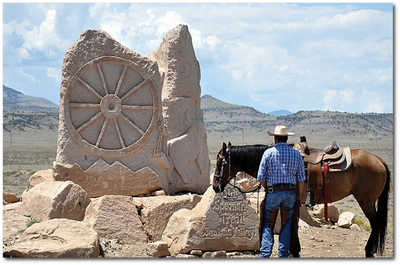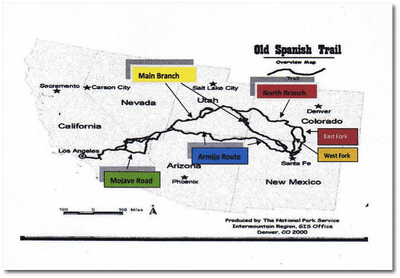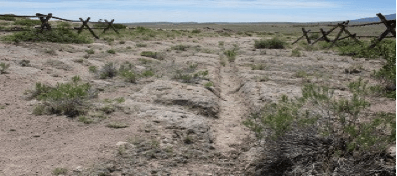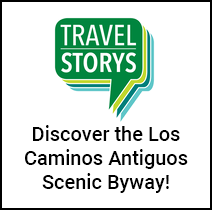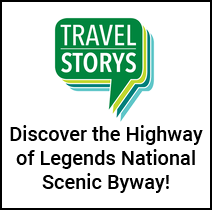Old Spanish Trail - La Verada del Norte Chapter
An "Outdoor Museum"
A Landmark can be found at the location indicated on the map at the right.
Contact: Ken Frye, President
La Vereda del Norte Chapter of the Old Spanish Trail Association.
Phone:
719-657-3161
Email:
kennruth@gojade.org
Did you know that the Old Spanish Trail Association (OSTA) started right here in the Visit San Luis Valley, Colorado? OSTA was established in 1994, in Del Norte, Colorado, with its first headquarters at the Rio Grande County Museum. Its first members were from southern and western Colorado. It soon grew to include members from California, Nevada, Arizona, Utah, and New Mexico. An earlier association in Utah had done considerable research on the trail routes and those who used it.
Photo credit/copyright: Dave Soldano
Trade Route Between Santa Fe and California
The Old Spanish Trail witnessed a brief but furious heyday between 1830 and 1848 as a trade route linking Santa Fe, New Mexico and Los Angeles, California. During that period, Mexican and American traders took woolen goods west over the trail by mule train, and returned eastward with California mules and horses for the New Mexico and Missouri markets.
The Trail left Santa Fe and split into two routes. The South or Main Branch headed northwest past Colorado's San Juan mountains to near Green River, Utah. The North Branch proceeded due north into Colorado's San Luis Valley and crossed west over Cochetopa Pass to follow the Gunnison and Colorado rivers to meet the Southern Branch near Green River.
From central Utah the Trail trended southwest to an area now shared by Utah, Nevada and Arizona. It crossed southern Nevada and passed through the Mojave Desert to San Gabriel Mission and Los Angeles.

Ancient Indian Trails
The Trail originated in ancient, native American Indian trade routes. Two of these routes ran north-south along the eastern and western margins of the upper Rio Grande Valley, between the adobe pueblos of present-day New Mexico and Colorado's San Luis Valley. Perhaps the oldest, in use for nearly 1,000 years, later became the West Fork of the North Branch.
Between 1598 and 1830, Spanish (1598-1821) and later Mexican (1821-1830), and American (1821-1830) traders connected these native trade routes to complete the Old Spanish Trail.
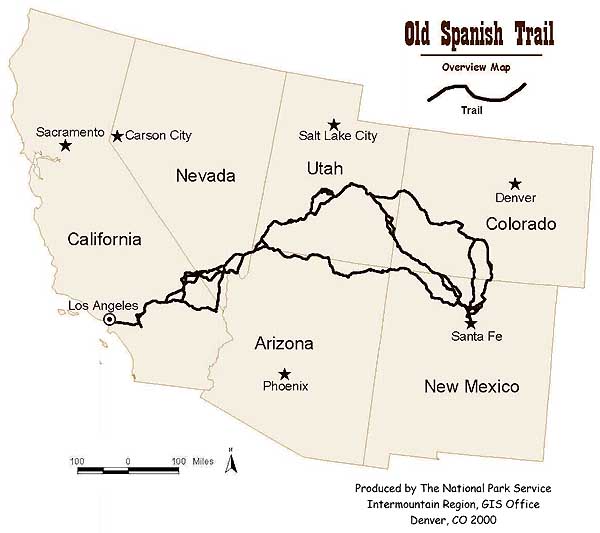
Early Spanish Expeditions
Well-documented Spanish expeditions that led from Santa Fe to central Utah, along the eastern half of the Trail, include Juan Maria Antonio de Rivera in 1765, the Dominquez-Escalante party of 1776, Manuel Mestas in 1805, and the Arze-Garcia party of 1813. But Spanish traffic was fairly constant between 1765 and 1821 to trade with the Ute, including for slaves.
In the 1820s, fur-trapping parties pushed west from New Mexico, following the Gila and Colorado rivers south of the Trail, while others used the Spanish route northwest from Santa Fe to trap the Green River in eastern Utah. These men included: Antoine Robidoux (who built forts on the North Branch), Ewing Young, Etienne Provost, William Wolfskill, George Yount, Jose Martin, Jedediah Smith, Kit Carson, and Ceran St. Vrain.
Mexican trader Antonio Armijo made the first commercial, round-trip journey along a southern variant of the route in 1829-1830. William Wolfskill and George Yount's commercial pack train of 1830-1831 inaugurated consistent use of the entire route from 1830-1848.
Use During the Mexican War
During the Mexican War, 1846-1848, the Americans' Army of the West conquered New Mexico, then blazed a new, southern variant of the route to California, hastening the end of the Old Spanish Trail. Several famous journeys were made along the Trail, from west-to-east, including one by Kit Carson and Lieutenant George D. Brewerton in 1848.
After the Mexican War, wagon roads on competing routes largely ended use of the Trail.
Government Mapping Expeditions
In the 1850s and 1860s, portions of the Trail's eastern end were mapped by U.S. government expeditions, while the western portion of the trail witnessed Mormons heading to California. U.S. government expeditions included Capt. John W. Gunnison in 1853, and Lieutenant E.F. Beale in 1853.
By then commercial traffic had died out, leaving wagon ruts visible where once only mules trod.
Today's Efforts To Preserve The Trail's Heritage
Modern historical scholarship on the Old Spanish Trail began in the 1920s, and resulted in LeRoy and Ann Hafen's Old Spanish Trail (Lincoln: University of Nebraska Press, 1954; reprinted 1993). Trail scholarship resumed in the 1970s, 1980s, and 1990s.
In May, 1994, Senator Ben Nighthorse Campbell, D-Colorado, introduced legislation in the U.S. Senate directing the National Park Service to study the Trail for possible inclusion in the National Historic Trails system. In June, 1994, Rep. Scott McInnis, R-Colorado, introduced similar legislation in the House of Representatives.
You can email or visit the website of the national Old Spanish Trail Association.
Read an 1853 letter:
written by
McClanahan published in November 7, 1853
Report - Old Spanish Trail by Suzanne Colville Off
Click here to download a PDF of the document.
La Vereda del Norte Chapter
Would you like to join the La Vereda del Norte Chapter located here in the San Luis Valley?
Send a check for $40 to:
OSTA Membership Coordinator
250 North Redcliffs Drive/4B #55
3Saint George, UT 8479
or send us an email if you'd like more info on our chapter.
Newsletters:


